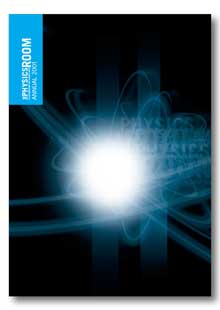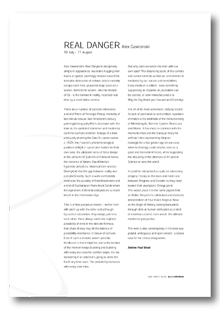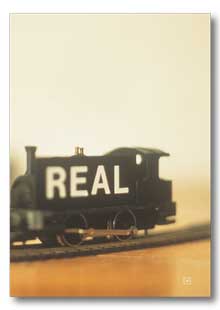 |
|||||||||
|
|
| ...Publications: Annual | ...REAL DANGER | |||||||
|
Real
Danger Alex Gawronski’s Real Danger is deceptively simple in appearance: two trains hugging their tracks at speed, seemingly headed toward the inevitable destruction of collision, only to narrowly escape each time, projected large scale on a screen. Behind the screen - like the Wizard of Oz - is the trainset in reality, recorded real-time by a small video camera. There are a number of possible references: a kind of Perils of Penelope Pitstop mentality of last minute rescue; late nineteenth century painting/photography/film’s obsession with the train as the symbol of dominion and modernity (and the Lumiere brothers’ footage of a train phallically entering the Gare St Lazare station, c.1900); the Futurist’s phenomenological positivist delight in speed and motion for their own sake; the pleasant sense of false danger in the unheimlich Sublime of Edmund Burke; the romance of steam; Baudrillardian hyperreal simulacra; historical train wrecks; Disneyland and the gap between reality and perceived reality. Such a work comfortably embraces the plurality of Post-Modernism and a kind of Duchampian Retro Avant Garde where the aspirations of the industrial past are so much kitsch in the Information Age. This is a false perpetual motion - neither train will catch up with the other and although, by careful calculation, they always just miss each other, there always exists the slightest possibility of error in the delicate formula, that chaos theory may tilt the balance of probability mechanics in favour of collision. Even if such a disaster wasn’t possible, the illusion is that it might be, and so the tension of the moment keeps building and building with every too-close-for-comfort swipe. It’s like wondering if an asteroid is going to strike the Earth any time soon. The probability increases with every near miss. But why can’t we watch the train with our own eyes? The distancing tactic of the camera and screen reminds us that our environment is mediated by our senses and sensibilities. Every medium is edited - even something supposedly as impartial as journalism can be slanted, or even manufactured a la Wag the Dog (thank you Foucault and Chomsky). It is art at its most ephemeral, defying record. Its lack of permanence and endless repetition of motion is the antithesis of the monumentality of Michelangelo, Bernini, Epstein, Branccusi and Moore. It has more in common with the memento mori and the Baroque fancy for artificial ruins representing Utopian nostalgia for a lost golden age (in our case, when technology could only be seen as a good and benevolent force), while suggesting the absurdity of the attempts of Art and/or Science to save the world. It could be interpreted as quite an interesting allegory: history as the neck and neck race between Progress and Disaster as they head toward their asymptotic Omega point. This would place it in the same pigeon hole as Walter Benjamin’s celebrated and elaborate interpretation of Paul Klee’s Angelus Nova as the Angel of History looking backwards through time at human civilisation as a kind of enormous cosmic train wreck: the ultimate modernist perspective. The work is also contemporary in the best way: playful, ambiguous and open-ended - a tabula rasa for the critical imagination. Andrew Paul Wood View REAL DANGER - Alex Gawronski - Essay by Andrew Paul Wood as a PDF This essay originally appeared in The Physics Room Annual
2001 Order your copy today from The
Physics Room !
|
|||||||


